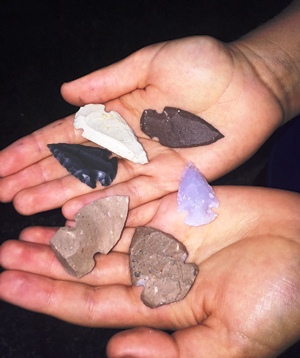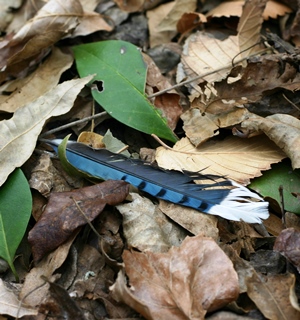In the beginning, there were no laws except the law of survival.
Over time, as survival became a bit easier, guidelines for human behavior began to evolve and formed the basis of our ethical framework. Early religions codified many of these guidelines, in some cases attaching the weight of law. Governments increased the number and reach of laws exponentially, until at times it seemed the need for ethics had passed.
What use is there for ethical guidelines when we have legal restrictions?
The reality is that ethics still play an important role in conserving natural resources and ensuring quality outdoor experiences. Today’s outdoor ethics require us to balance our interests with conservation needs and what’s within the scope of the law.
Collecting Consequences
 The act of "collecting" is ingrained into the human psyche. It seems so natural, so harmless. When we take a walk in the woods, we want to pick a flower, pocket a rock, or stick an owl feather in our hats. However, depending on our location, those natural inclinations might be frowned upon – or against the law.
The act of "collecting" is ingrained into the human psyche. It seems so natural, so harmless. When we take a walk in the woods, we want to pick a flower, pocket a rock, or stick an owl feather in our hats. However, depending on our location, those natural inclinations might be frowned upon – or against the law.
Picture this: It is a beautiful summer day in the Blue Ridge Mountains. You and your family are enjoying a day hike along a portion of the Appalachian Trail. As you climb out of the forest into an open meadow, you enter a spectacular vista of wildflowers. Your two young daughters laugh joyfully.
"Dad, can we pick some flowers for Mom? Can we?"
You remember seeing a sign at the visitor center asking people not cut flowers or remove plants while hiking. But there are thousands of flowers in this meadow. What could it hurt to take a few?
Millions of wildflowers are plucked each year by children and adults. But what seems at first to be an innocent act can add up to far-reaching consequences. If flowers from this meadow are removed by thousands of visitors over multiple years, the plants may not be able to effectively reseed themselves and the vegetative colony may perish – a result that has been documented on lands managed by the U.S. Forest Service. The cascading impact can result in the loss of local pollinators and disrupt entire ecosystems of insects, birds, and small animals that evolved to depend on seeds, nectar, and pollen from those wildflowers.
Insects themselves are the most heavily collected animals. Millions of people maintain insect collections. Although collectors are not the primary cause of insect declines (pesticides, pollution, and development are the top factors), they can tip an already sensitive species over the edge because collectors often target the most unusual species. Organizations of insect collectors such as the Amateur Entomologists’ Society have developed guidelines that, although voluntary, provide an ethical context to help keep insect collection within reasonable limits. The most important of these guidelines emphasize photography and live examination followed by release of the insect unless it is required for scientific study. (Insect identification apps can help with cataloging your finds.)
Finders Keepers?
 The collection of shed antlers is another popular and rapidly expanding outdoor activity. The average hiker or hunter who collects a shed antler will have a negligible impact on wildlife habitat. However, shed antlers sell for between $6 and $15, depending on their age and condition, which makes shed hunting a business in many places – and makes high-volume collectors part of the equation. The removal of thousands of shed antlers removes a vital source of calcium and minerals for rodents such as squirrels, chipmunks, and porcupines as well as larger mammals that gnaw on antlers, including wolves and bears. An even more direct impact on wildlife comes from thousands of shed hunters traveling through deer and elk ranges in late winter and early spring, when the animals are most vulnerable. Although people on foot and horseback are disruptive to wildlife, animals tend to move out of the way in a controlled fashion. However, deer and elk startled by off-road vehicles are likely to depart more rapidly and travel farther away, using what’s left of their already depleted energy stores to escape the perceived danger.
The collection of shed antlers is another popular and rapidly expanding outdoor activity. The average hiker or hunter who collects a shed antler will have a negligible impact on wildlife habitat. However, shed antlers sell for between $6 and $15, depending on their age and condition, which makes shed hunting a business in many places – and makes high-volume collectors part of the equation. The removal of thousands of shed antlers removes a vital source of calcium and minerals for rodents such as squirrels, chipmunks, and porcupines as well as larger mammals that gnaw on antlers, including wolves and bears. An even more direct impact on wildlife comes from thousands of shed hunters traveling through deer and elk ranges in late winter and early spring, when the animals are most vulnerable. Although people on foot and horseback are disruptive to wildlife, animals tend to move out of the way in a controlled fashion. However, deer and elk startled by off-road vehicles are likely to depart more rapidly and travel farther away, using what’s left of their already depleted energy stores to escape the perceived danger.
For the casual collector, bird feathers are almost as popular as flowers. Who among us has not picked up a pretty feather found on the ground? In some cases, doing so is perfectly acceptable – with emphasis on the word "some." In an effort to stop the commercial slaughter of birds for their feathers (which were in high demand for women’s fashion at the turn of the 20th century), the Migratory Bird Treaty Act of 1918 established federal protection for all migratory birds, making it illegal even to possess their feathers. The list of protected birds includes the majority of birds native to North America. Find a shiny black crow feather? Illegal. How about a bright orange feather from the Northern flicker? Leave it there. Hawk, owl, or eagle feathers? With raptors you are now ranging into felony territory. Feathers from non-native species – including pheasants, starlings, chukars, and English sparrows – are fine, as are non-migratory birds including turkeys, quail, and most grouse. But as for the rest, unless you’ve got a federally issued permit, you are legally required to leave the feather (or other body part) where you found it.
Right about now, you might be feeling a bit exasperated (and understandably so). How can it be illegal to collect bird feathers, even feathers that were naturally molted? This aspect of the Migratory Bird Treaty Act is probably among the least understood – and most regularly ignored – federal laws in our country. Because some feathers are still commercially valuable and there’s no way to tell whether a feather was naturally shed or taken from a killed bird, these laws remain in place.
Are you going to be hauled off to jail for picking up crow feathers? Of course not. But sometimes ethical behavior requires us to obey a law we don’t understand or believe in, even when the chances of being given a citation are negligible.
Hardscape Souvenirs
Rock collection is another widespread hobby, particularly among kids, and there are many opportunities for recreational "rockhounders" on public lands. These are generally limited to lands administered by the Bureau of Land Management, the U.S. Forest Service, and certain state agencies. Because of the overwhelming number of people who visit national parks, the National Park Service prohibits rock collection. Even with these laws in place, however, people grabbing small souvenirs can result in startlingly high losses. For example, 645,000 visitors to Petrified Forest National Park in Arizona cart off an estimated 12 tons of petrified wood each year. Rocks with unique properties or bright colors – such as obsidian, jade, agates, and geodes – are particularly popular targets. Organizations of rock hunters have developed ethical guidelines for rock collection in areas where it is legal. The American Federation of Mineralogical Societies maintains an excellent code of ethics for its member organizations).
Perhaps the most contentious (and confusing) of all collection issues involves American Indian and Civil War artifacts. The Archaeological Resources Protection Act of 1979 (ARPA) stipulates that no collection of archeological specimens is permitted on lands owned or managed by the federal government. Unfortunately, the perceived value of these relics continues to drive destruction of historic sites. Just last May, staff at Petersburg National Battlefield in Virginia found a series of pits dug by looters. The laws in this case are clear. For the average visitor who stumbles on an arrowhead or bullet during a park visit, however, the rules are a bit more confusing. ARPA’s restrictions do not apply to coins and bullets unless they are found in "direct physical relationship with another archaeological resource." It also excludes "arrowheads located on the surface of the ground." However, most visitors cannot identify "another archaeological resource" on a national battlefield that spans thousands of acres, and something that looks like an "arrowhead" lying on the ground at a cultural site may be a different type of projectile altogether. Archaeologists suggest that visitors leave all such artifacts where they found them.
Ethics Still Integral to Outdoor Behavior
Legal frameworks are in place to protect historic artifacts as well as vulnerable natural resources. And those laws are important. There are simply too many visitors to parks and monuments to allow unregulated collection.
But in the wide open spaces, we’ve come full circle. Because discovery and apprehension are so unlikely that they present almost no threat to anyone who breaks the law, a belief in what is right and good and a willingness to live by those beliefs is a far more effective deterrent to illegal collection than are laws. In the end, it comes back to what we care about the most and what we believe. It’s all about ethics.